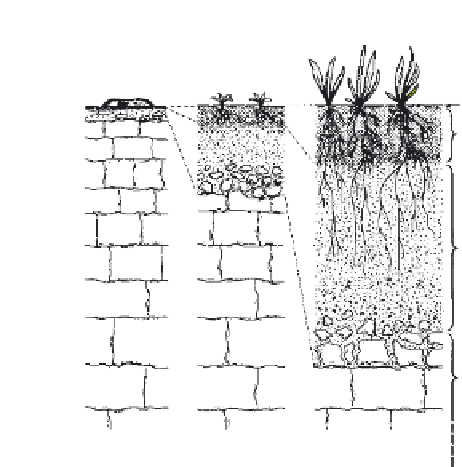Agriculture Reference
In-Depth Information
Mosses
Horizons:
leaf litter
LL
A (topsoil)
A
e.g.
Alluvium
B
B (subsoil)
C
e.g.
Colluvial
soil
C (parent
material)
I
II
III
Stages in the formation of sedentary soils
Transported soil
Figure 12.6
The formation of soil. The change from a young soil comprising a few fragments rock particles
to deep sedentary soil is shown alongside a transported soil. Subsoil, topsoil and leaf litter horizons can
be identifi ed in each soil. Simple plants such as lichens and mosses establish on rocks or fragments to be
succeeded by higher plants as soil depth and organic matter levels increase
much of it into the layers below (see primary
decomposers p. 38). It is also a source of nutrients for
the next generation of plants. The natural development
is for there to be a steady decline in the organic matter
levels away from the surface until none is found below
the root zone. This can be seen because the organic
matter gives rise to a black 'jelly' (see humus p. 158)
that coats all the particles. However, once a soil has
been cultivated, the disturbance of the top layers gives
rise to a distinct boundary between light-coloured
subsoil
and the darker
topsoil
. While this spreads the
beneficial effect of organic matter to cultivation depth,
it should be noted the disadvantage is that it reduces
the concentration of it at the surface.
The topsoil is richer in organic matter because
most of the roots are near the surface, particularly
in the top 15-30 cm. The plant remains that fall on
the surface are taken down into the top layers by
earthworms and many types of insect. The presence
of undecomposed organic matter and the burrowing
of earthworms tend to keep the topsoil 'open', that
is, a high proportion of air spaces. The topsoil is
exposed to more extreme effects of weather such as
freezing and thawing, wetting and drying whereas the
subsoil tends to be buffered from such. As it is near
the surface, topsoil is within the range of cultivating
equipment but this also makes it vulnerable to
compaction by feet or wheeled traffic. All the dead
organic matter that accumulates there is a source of
food that attracts a vast population of living organisms
(see Chapter 13). The topsoil is richer in nutrients as
a result of the decomposition of the organic matter
or because fertilizer is added at or near the surface of
the soil. The colouring of
subsoil
depends greatly on
the chemicals coating the particles, commonly iron
oxide. In well-drained soils, the iron oxide present
is in an oxidised form, giving the soil a rusty brown
colour, but in waterlogged (anaerobic) conditions
the iron oxide is reduced to a form that has a grey
or bluish tone. Subsoils tend to accumulate the finer
soil particles washed down from above, making
them 'heavier', that is, with a higher clay content.
This accumulation and the reduced biological activity
(especially roots and earthworms) lead to poorer
water and air movement.
Topsoil and subsoil
There are several important differences between
topsoil and subsoil that affect growing plants. The
differences are largely because of the topsoil being
nearer the surface (see Table 12.2).
Topsoil
is the uppermost layer of soil normally
moved during cultivation. It is typically 10-40 cm
deep and darkened by the decomposed organic
matter it contains.
Subsoil
is the layer below the cultivated layer
and lighter in colour because of its low organic
matter level.


















































